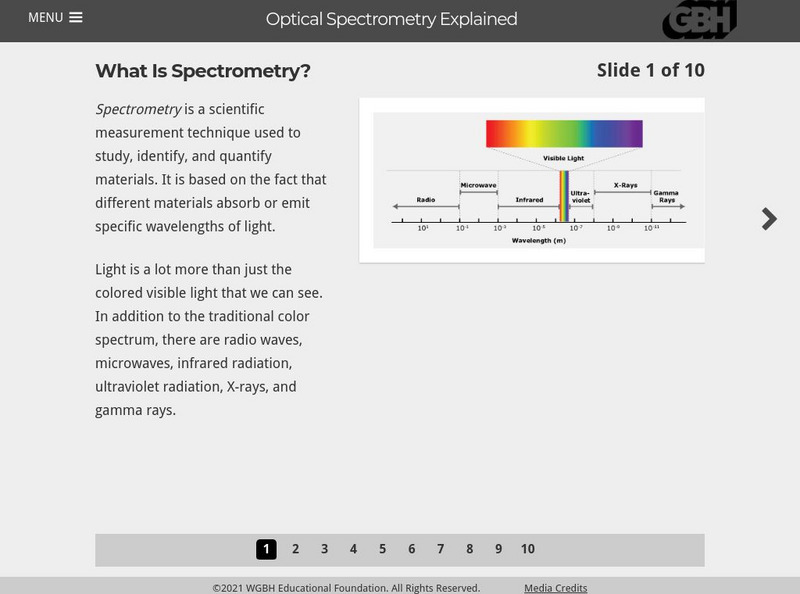PBS
Pbs Learning Media: Scientific Processes
In this interactive activity adapted from NOVA, expand your understanding of the scientific process. Watch two videos featuring animations and interviews with scientists, and notice how the processes unfold and vary from one...
PBS
Pbs Learning Media: The Sense of Taste
This video segment explores the sense of taste in humans -- why we have it, and what happens when we lose it. Footage from NOVA: "Mystery of the Senses: Taste." Includes background reading material and discussion questions. [4:18]
PBS
Pbs Learning Media: The Fastest Broom
The CyberSquad tests which broom can travel the furthest in five seconds in this video from Cyberchase.
PBS
Pbs Learning Media: Zombie Autopsies: Spooky Psychiatric Medicine to Save World
After looking at zombies to learn about brain disease that alters behavior, students now must develop a cure for zombies. They use Skittles, where each color represents a different neurotransmitter. They then present their cure to the...
PBS
Pbs Learning Media: American Exp:primary Resources: Second Inaugural Address 1937
President Franklin Roosevelt's second inaugural address delivered in 1937. In this speech FDR calls for the nation to accept and prepare to move forward.
PBS
Pbs Learning Media: American Exp: Primary Resources: Nixon's Checkers Speech
Dwight Eisenhower's Vice President, Richard Nixon, came under fire for misusing political contributions for personal expenses. These are transcripts of Nixon's speech delivered in 1952.
PBS
Pbs Learning Media: Spectrometry Explained
This interactive tutorial illustrates how spectrometry is used to study, identify, and quantify materials.
PBS
Pbs Learning Media: Characteristics of the Sun
This video segment adapted from NASA describes the basic characteristics of our star, the Sun. Includes background reading material and discussion questions. Video length: 1 min. 28 sec.
PBS
Pbs Learning Media: Super Why! Wonder Red Rhyme Time Bingo
In this interactive game, the character Wonder Red reads aloud a word to prompt the player to find another word that rhymes with it. The process is repeated until the entire BINGO card reveals a printable picture.
PBS
Pbs Learning Media: Primary Resources: Monroe Doctrine, 1823
A transcript of the Monroe Doctrine written by President James Monroe in 1823. This document established a foreign policy that any European nations attempting to colonize in North or South America would be seen as aggression and the...
PBS
Pbs Learning Media: American Exp: Southern Response to Civil Rights Speech, 1948
In response to Harry Truman's views of civil rights, a Democrat from Mississippi voices his displeasure in the concept of a Civil Rights Movementto grant equal freedoms to all citizens of the United States.
PBS
Pbs Learning Media: Curious George: Sail a Boat
In the Curious George video Junky Monkey, George sees treasures where others see trash. He transforms his junk collection into a masterpiece- reusing and recycling items from the street. Will the mayor declare George and his friends the...
PBS
Pbs Learning Media: Night Light Video
Watch PEEP and Quack [8:49] have fun with shadows in the middle of the night using flashlights. They learn that shadows can grow and change shape by rotating the object. An additional hands-on activity is provided for students along with...
PBS
Pbs Learning Media: Shadow Shape Game
Play with PEEP to explore how shadows change when the position of light changes. Detailed teaching tips are included as well as additional shadow activities for the students.
PBS
Pbs Learning Media: Social and Cultural Perspectives of Dogs
In this video segment from Nature, learn about the role of dogs in the lives of humans.
PBS
Pbs Learning Media: Centripetal Force: Roller Coaster Loops
This video segment explains centripetal force and illustrates how roller coasters rely on it to give you a thrilling ride. Includes background reading material and discussion questions. [4:40]
PBS
Pbs Learning Media: Farming the Desert: The Science Behind Desertification
This lesson introduces students to the factors that contribute to desertification and solutions that have been implemented in the Sahel region of West Africa. A 21-page teaching guide is also provided. [4:39]
PBS
Pbs Learning Media: Farming the Desert: Geography of the Sahel
This lesson is provided to introduce students to the geography and people of the Sahel region and to have them discover the challenges and conflicts faced by the inhabitants. They learn about desertification and what farmers are doing to...
PBS
Pbs Learning Media: Coastal Geological Processes
This interactive resource adapted from the National Park Service describes the many forces that affect shorelines, including tides, weathering, erosion, and deposition. Includes background reading handout and discussion questions.
PBS
Pbs Learning Media: Super Why! Spectacular Sounds Bingo!
This interactive Super Why! game features a BINGO game. Students listen to Princess Pea read aloud the following: initial vowel sounds, initial consonant sounds, and/or words with emphasized initial vowel or consonant sounds. Then...
PBS
Pbs Learning Media: Circular Motion
In this interactive activity featuring videos adapted from the Rutgers PAER Group, students will observe examples of circular motion. Students will then find a common reason why the objects and people presented move in a circle. Includes...
PBS
Pbs Learning Media: Momentum
In this interactive activity adapted from Wake Forest University, students will observe the effect of mass on velocity and momentum in elastic and inelastic collisions. Includes background reading, a student handout, and discussion...
PBS
Pbs Learning Media: Great Ocean Conveyor Belt: Part I
This image from GRID-Arendal depicts the major circulation pattern of the ocean, illustrating interactions between temperature, salinity, and depth. Includes a background reading handout and several discussion questions.
PBS
Pbs Learning Media: Observing Refraction of Light
This video segment adapted from Shedding Light on Science illustrates how light changes speed, and thus direction, in a process known as refraction. Includes background reading and discussion questions. [2:05]



